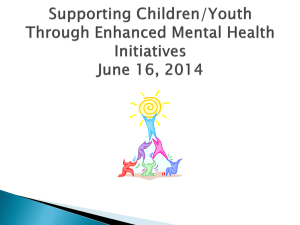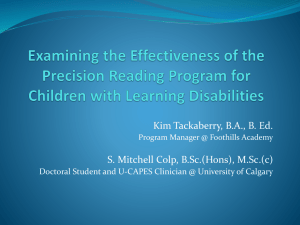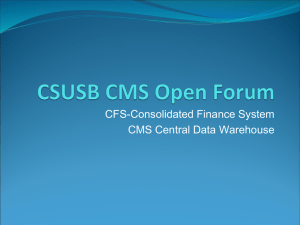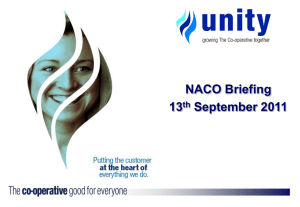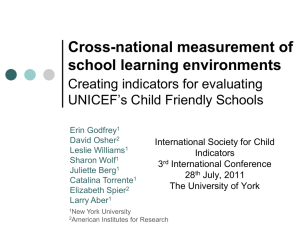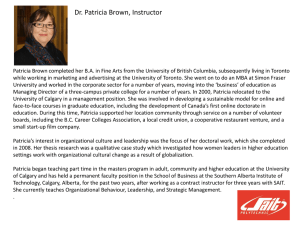Workshop Overview
advertisement
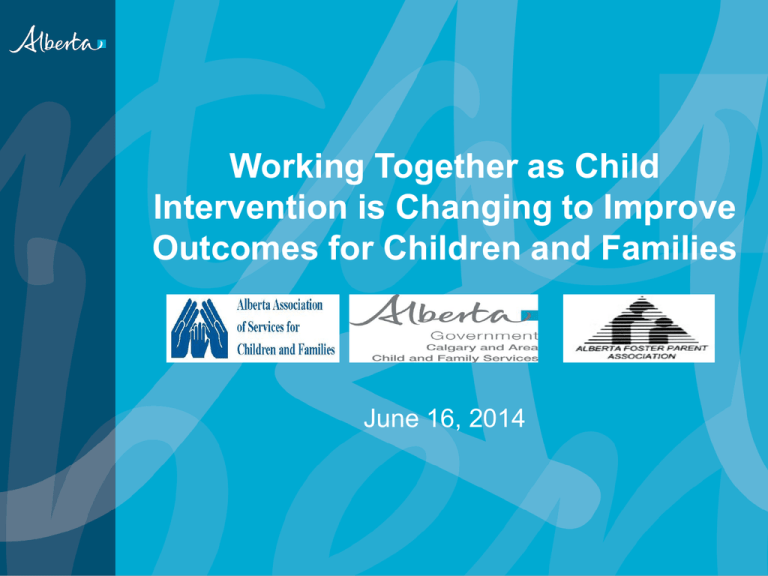
Working Together as Child Intervention is Changing to Improve Outcomes for Children and Families June 16, 2014 Jon Reeves Regional Director Calgary and Area Child and Family Services 2 Calgary and Area CFS 1. 2. 3. 4. 5. 6. 7. Child Intervention Practice Framework Practice Principles Outcomes Four Priorities Research and Trends in Child Intervention Re-cap Changing Roles 3 Calgary and Area CFS Future Direction Child Intervention Practice Framework 6, 5, 4 4 Calgary and Area CFS Future Direction Child Intervention Practice Framework • Child Intervention practice in Alberta has, by evolution is become evidenced informed and collaborative based. • A child intervention practice framework is a natural and expected continuation of a commitment to improving outcomes for children and families. 5 Calgary and Area CFS Future Direction Child Intervention Practice Framework • A well-defined practice framework supports everyone involved in Child Intervention, provides confirmation that their work is important and valued, and guides their efforts to achieve the best possible outcomes for vulnerable children, youth, and families • A practice framework outlines the core principles that underlies our approach to working with children, youth, families, and communities • The practice principles have now been affirmed and work is underway to embed the principles throughout the organization 6 Calgary and Area CFS Future Direction Child Intervention Practice Framework 7 Calgary and Area CFS Future Direction Practice Principles 1. Aboriginal Experience First Nations, Métis and Inuit people have always had their own ways of ensuring that vulnerable members, including children, are safe and protected. We honour this by recognizing their expertise in matters concerning their children, youth and families. 2. Connection Children and youth are supported to maintain relationships that are important to them, be connected to their own culture, practice their religious beliefs and, for those in care, have a plan for their care where they are included in the decision-making process. 8 Calgary and Area CFS Future Direction Practice Principles 3. Collaboration We are child-focused and family-centred. We collaborate with families, community agencies, and other stakeholders in building positive, respectful partnerships across integrated multidisciplinary teams and providing individualized, flexible and timely services to support these efforts. 4. Continuous Improvement We share and use information appropriately. Our approach is outcome-oriented and evidence-based therefore we support innovative practice, monitor our performance and strive for continuous improvement. 9 Calgary and Area CFS Future Direction Practice Principles 5. Strengths-based Our approach is reflective, culturally responsive and strengthsbased. Because all families have strengths and resources, we recognize and support the right and responsibility of parents to share in the decision-making process for them and their children. 6. Preserve Family We believe children and youth should be safe, healthy and live with their families, therefore we focus on preserving and reuniting families and building on the capacity of extended family and communities to support children, youth and families. 10 Calgary and Area CFS Future Direction Outcomes 1. Vulnerable children live successfully in their community 2. Children in temporary care are reunited quickly with family 3. Children in permanent care are placed in permanent homes more quickly 4. Youth transition to adulthood successfully 5. Aboriginal children live in culturally appropriate homes 11 Calgary and Area CFS Future Direction Four Priorities 1. Improving Child Intervention Practice 2. Aboriginal & Cultural Engagement 3. Prevention and Early Intervention 4. Organizational Culture 12 IMPROVING CHILD INTERVENTION PRACTICE 13 Improving Practice -Front End Enhancements -Signs of Safety -Ongoing Case Management -Kinship and Family Teaming -Enhancing Permanency -Youth -Caregiver Support -OBSD 14 Improving Child Intervention Practice Front End Enhancements • Started in April 2013 • Used AB Incidence Study 2008 as beginning foundation • 6 areas implementing beginning in July 2013 • Edmonton, Region 7 and 10, Calgary and 2 DFNA’s • Practice Shift Assessment Currently underway • Based on the 6 principles of the Child Intervention Practice Framework • Support the 5 outcomes for children and families 15 Improving Child Intervention Practice Front End Enhancements Four Key components: • Supervisor Consults • In Care Consultations • Family/Natural Support Meetings • Reinforce Collaboration with Aboriginal Communities 16 Signs of Safety (SoS) • The SoS is one such initiative that harmonizes with Child Intervention Practice Framework core values and principles Signs of Safety as one such initiative that supports the core values and principles to improve Alberta child intervention service delivery to families and children. • SoS enhances the entire spectrum of child intervention, from front-line staff practice, to the roles and responsibilities of supervisors and managers, to on-going practice support for continues improvement in the discharge of Alberta child intervention duties in a flexible, values-based ethical way • SoS is a child intervention practice approach that is designed to create a shared focus amongst all stake holders and facilitate professional collaboration in working with families 17 Improving Child Intervention Practice Ongoing Case Management Three key areas identified for ongoing case management are: • Applying Front End and Signs of Safety Strategies to ongoing cases • Addressing the medical needs of children and youth • Addressing the mental health needs of children and youth through supports to caseworkers and caregivers 18 Improving Child Intervention Practice Ongoing Case Management Addressing the medical needs of children and youth: Pediatrics for Kids in Care is reviewing youth and children who came into care prior to P-KIC and ensuring they have access to a comprehensive pediatric assessment, oral health and a medical home role of foster care, kin, group and residential caregivers role of caseworker 19 Improving Child Intervention Practice Kinship Enhancement & Family Teaming • Strategic Objective: To increase the number of children placed in kinship care, by defining and realigning kinship care with the outcome of increasing placements in kinship care. – History – Current Status – 2014-15 Activities and Focus • Kinship Search • Cultural Kinship • Family Teaming 20 Improving Child Intervention Practice Enhanced Permanency Relationship • Enduring relationships • Recognizes the value of past and current significant relationships • Maintaining a child’s positive connections to family history, traditions, race, ethnic heritage, culture, community religion and language • Maintains child’s connections to extended family, siblings, and other significant adults 21 Improving Child Intervention Practice Enhanced Permanency Placement • Stable placements • Minimal disruptions • Sense of belonging • Healthy attachments Legal • Adoption • Private guardianship 22 Improving Child Intervention Practice Caregiver Support In support of achieving our desired outcomes for our children in care, we will be supporting our caregivers in a different way. Support initiatives will be directed in three target areas: 1. improving child well being 2. increasing caregiver capacity 3. emphasizing caregiver connection to the child’s case team and an integrated plan 23 Improving Child Intervention Practice Reconnect Youth • Lifelong partnerships are an essential part of permanency • Permanency outcomes and options look different for youth with most (92%) aging out of permanent care • We need to look at more creative ways to meet the permanency goals for youth • Regional Youth Teams • Current formation of Youth Assessment Team that will focus on our Front End strategies and using SOS, along with our partnering agencies at the HUB. • Future Steps: Contracting SIL etc. 24 Improving Child Intervention Practice Outcome-Based Service Delivery (OBSD) OBSD….the journey continues: OBSD started in Region 3 July 2009 with Woods Homes and the Forest Lawn MST Aboriginal OBSD started July 2013 with an alliance of Pathways, Boys and Girls Club and Enviros called Mahmawi-atoskiwin Through OBSD the CFS and lead agency work collaboratively to achieve the 5 outcomes Measurement of Outcomes data (Provincially and Regionally) show OBSD sites achieve better outcomes in family preservation, family reunification and reoccurrence after file closure 25 Improving Child Intervention Practice Outcome-Based Service Delivery (OBSD) OBSD…the journey continues: Collaboration is a key principle of OBSD and is also a key principle of the Child Intervention Practice Framework, Signs of Safety practice approach and Front End practice approach Having OBSD with a lead agency provides increased opportunities for flexible, responsive and creative service provision Provincially and Regionally OBSD agencies are developing consistent tools and interpretation of the tools for assessing and measuring child development and parenting capacity over time and the effectiveness of interventions i.e. Ages and Stages, Family Assessment Tool, CAFS. 26 Improving Child Intervention Practice Outcome-Based Service Delivery (OBSD) Next Steps OBSD will continue to be implemented in Region 3. Learnings from Woods/Forest Lawn, Aboriginal Services/Mahmawi-atoskiwin, other provincial OBSD sites and the current practice shifts will be used to inform the continued implementation of OBSD. Based on current practice shifts, OBSD agency role will focus on the early involvement and front end practice. OBSD agencies will be expected to focus on increasing family wellness and utilizing models that have promising evidence and research. The gradual implementation of OBSD will continue this fall with a tender. 27 Aboriginal and Cultural Engagement 28 Aboriginal and Cultural Engagement Aboriginal Framework • 2009, began the development of the Aboriginal Framework Principles • Culture and Language • Self Determination • Holistic Approach • Ongoing Learning/Best Practice 29 Aboriginal and Cultural Engagement Diverse Cultures • Cultural brokerage program with Muslim community • Expanding cultural brokerage program to include ethno cultural backgrounds (of the majority of our referrals) • The Cultural Brokerage Program will: – Centre around the mentorship and connection of children and youth to their community – Assist families with navigating with CI – Awareness/prevention/education between ethno cultural committees and ourselves. – Cultural kinship/foster care recruitment 30 Prevention and Early Intervention 31 Prevention and Early Intervention (EI) As a region, we are committed to implementing the Prevention and Early Intervention Framework 32 Prevention and Early Intervention (EI) • The framework is about implementing a continuum of evidence-based prevention and early intervention services that will effectively address the key drivers that cause children and youth to require child intervention services. • There are a number of key elements of the framework which will influence and shape the work we want to do in the region. 33 Calgary and Area CFS Future Direction Research and Trends in Child Intervention 34 Calgary and Area CFS Future Direction Research and Trends in Child Intervention Front-End Practice Sites CFSD Resulted in Intervention 85/15 35 Calgary and Area CFS Future Direction Research and Trends in Child Intervention Front-End Practice Sites CFSD - Resulted in Intervention 60.00% 50.33% 48.94% % of Intakes that Resulted in Intervention 50.00% 38.24% 40.00% 30.41% 30.10% 28.48% 28.40% 28.18% 27.04% 17.96% 30.00% 23.62% 26.23% 27.03% 2010-2011 2011-2012 22.54% 2012-2013 2013-2014 20.00% 15.63% 12.79% 10.00% 0.00% R03 R06 R07 Regions R10 36 Calgary and Area CFS Future Direction Research and Trends in Child Intervention Caseload Trends in Region 3 Service Sooner More At Home More Engagement More Kinship 37 Calgary and Area CFS Future Direction Research and Trends in Child Intervention 1. Screening Started by Group I.D. 900 800 700 600 500 400 300 200 100 0 Apr 2011/12 636 2012/13 705 2013/14 675 May 746 764 770 Jun Jul Aug Sep 674 572 591 702 783 674 579 634 667 642 572 624 Oct 674 711 631 Nov 725 773 647 Dec 647 606 547 Jan 629 721 675 Feb Mar 638 681 653 691 613 Avg 660 691 642 38 Calgary and Area CFS Future Direction Research and Trends in Child Intervention 4. CP & FE Caseload 4,000 3,500 3,000 2,500 2,000 1,500 1,000 Apr 2011/12 3,119 2012/13 3,248 2013/14 3,169 May 3,190 3,234 3,178 Jun Jul Aug Sep 3,315 3,386 3,425 3,398 3,302 3,260 3,311 3,300 3,125 3,053 2,993 2,889 Oct 3,374 3,342 2,826 Nov 3,368 3,335 2,731 Dec 3,340 3,326 2,620 Jan 3,274 3,286 2,577 Feb Mar 3,216 3,242 3,198 3,181 2,495 Avg 3,304 3,277 2,878 39 Calgary and Area CFS Future Direction Research and Trends in Child Intervention 5. Family Enhancement Caseload 900 800 700 600 500 400 300 200 100 0 Apr 2011/12 691 2012/13 771 2013/14 748 May 724 775 748 Jun 791 782 740 Jul 825 757 733 Aug 810 789 745 Sep 808 789 712 Oct 761 823 702 Nov 749 803 666 Dec 740 772 630 Jan 707 782 658 Feb 697 739 627 Mar 741 726 Avg 754 776 701 40 Calgary and Area CFS Future Direction Research and Trends in Child Intervention 8. In-care Caseload 2,200 2,000 1,800 1,600 1,400 1,200 1,000 Apr 2011/12 1,936 2012/13 1,974 2013/14 1,903 May Jun Jul Aug 1,963 1,990 1,987 2,016 1,989 2,000 1,970 1,971 1,905 1,869 1,854 1,812 Sep Oct Nov Dec Jan Feb Mar 2,033 2,033 2,039 2,000 1,982 1,981 1,978 1,956 1,982 2,002 1,992 1,971 1,925 1,935 1,774 1,746 1,728 1,695 1,651 1,641 Avg 1,995 1,972 1,780 41 Calgary and Area CFS Future Direction Research and Trends in Child Intervention 9. Kinship Care 500 450 400 350 300 250 200 150 100 50 0 Apr 2011/12 285 2012/13 350 2013/14 392 May 279 355 389 Jun 270 354 383 Jul 280 321 376 Aug 287 313 364 Sep 322 311 364 Oct 337 312 375 Nov 355 341 363 Dec 356 357 366 Jan 351 385 367 Feb 351 390 365 Mar 363 389 Avg 320 348 373 42 Calgary and Area CFS Future Direction Re-cap 43 Calgary and Area CFS Future Direction - Recap • Focus on 4 priorities • Realign front end service delivery • Use research and data to enhance practice – Alberta Incident Study – Brain Development Research • Use evidence informed and best practice programming to meet our outcomes 44 Changing Roles – How will foster care and kinship fit into this “new world of practice • Reunification • Permanency • Complex child and youth management 45 Calgary and Area CFS Future Direction Questions? 46

